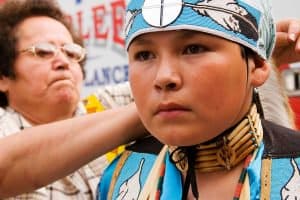
Everyday Native is garnering early praise from teachers in Montana, South Dakota, Idaho, and California for its content that offers extended learning opportunities. These educators welcome its positive message and how it dispels stereotypes of Native peoples.
The content – which enriches Language Arts, Native American History, U.S. History, Social Studies, Current Events, Art and more — is reviewed by Lakota and Salish educators to ensure accuracy and cultural sensitivity.
Creating Social Consciousness: Bridging the Gap between Native and non-Native Youth
“Leo wears his hair in the three-braid style that is traditional for Blackfeet boys. His hair and light skin have created problems for him.” So begins the Everyday Native chapter, “Walking in Two Worlds,” with the story of Leo Kipp who now lives on the Blackfeet Reservation in western Montana. Students learn about Leo’s life helping on his grandparents’ ranch, learning his indigenous language at an immersion school, and dealing with the painful circumstances of racial bullying, whether it’s being teased for his braids or being targeted for his light skin. Each chapter of Everyday Native includes discussion and writing sections that follow Native youths’ stories, tribal histories, and culture. Sections ask students to think about highlighted youths’ experiences and also relate them to their own. Project ideas take learning beyond classrooms and into communities.
Everyday Native was created by founder-photographer Sue Reynolds with educator Cass Fey, former education director for The Center for Creative Photography at the University of Arizona, Tucson. Both are non-Native. Beautiful, eye-opening poems by Salish Indian poet Victor Charlo appear throughout the resource, providing insights into this renowned storyteller’s everyday life on and off the reservation. Reynolds stays in touch with many Native families seen in the resource so that updates help keep website content accurate and relevant.
Everyday Native launches in late July. Once it goes live, teachers, students, parents, and the public can go to www.everdaynative.com to register for a free account, and before launch they can sign up for launch notification.







